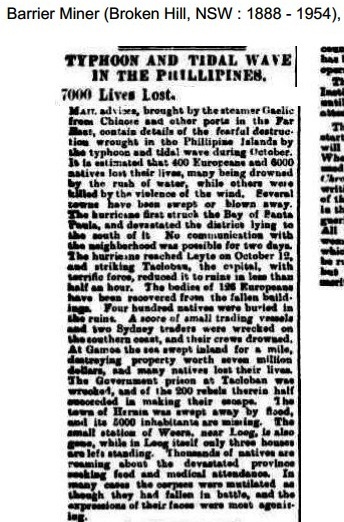 As appalling as it was, it turns out the Typhoon Yolanda (Haiyan) was perhaps not as unique as we were led to believe. True, in modern times – with the exception of the 1991 Ormoc Flood caused by Tropical Storm Uring – the areas devastated by the typhoon have largely escaped the full force of the Philippines’ annual typhoons. And Typhoon Yolanda was exceptionally powerful, perhaps the most powerful storm to make landfall since records of such things were first kept. But Typhoon Yolanda was not a first for the Leyte-Samar area.
As appalling as it was, it turns out the Typhoon Yolanda (Haiyan) was perhaps not as unique as we were led to believe. True, in modern times – with the exception of the 1991 Ormoc Flood caused by Tropical Storm Uring – the areas devastated by the typhoon have largely escaped the full force of the Philippines’ annual typhoons. And Typhoon Yolanda was exceptionally powerful, perhaps the most powerful storm to make landfall since records of such things were first kept. But Typhoon Yolanda was not a first for the Leyte-Samar area.
On October 12, 1897, a storm of similar ferocity arrived in Leyte, “striking Tacloban, the capital, with terrific force,” according to a newspaper article in the Barrier Miner newspaper of Broken Hill, New South Wales, which didn’t receive the news until January, 1898:
| SUPPORT INDEPENDENT SOCIAL COMMENTARY! Subscribe to our Substack community GRP Insider to receive by email our in-depth free weekly newsletter. Subscribe to our Substack newsletter, GRP Insider! Learn more |
Some of the descriptions of the aftermath – 7,000 were reportedly killed in the storm and its accompanying “tidal wave” – are eerily similar to the scenes being played out on television for a worldwide audience over the past week:
“At Gamoa, the sea swept inland for a mile, destroying property worth seven million dollars, and many natives lost their lives. The Government prison at Tacloban was wrecked, and of the 200 rebels therein half succeeded in making their escape. The town of Hermin was swept away by flood and its 5000 inhabitants are missing. The small station of Weera, near Loog, is also gone, while in Loog itself only three houses are left standing. Thousands of natives are roaming about the devastated province seeking food and medical attendance. In many cases the corpses were mutilated as though they had fallen in battle, and the expressions of their faces were most agonising.”
Only 15 years later it would happen again, this time killing or injuring 15,000 people, as The Oswego Palladium (Oswego, New York), reported on November 29, 1912:
“TACLOBAN IS DESTROYED – While the dispatch from the Governor-General of the Philippines gives us figures of the dead and wounded, it states that probably half the population of Tacloban and Capiz have been lost….The Red Cross is preparing to rush a relief [illegible] to the stricken district, and has been asked for details.”
(As a point of attribution, I am uncertain what the source of the photo and report is, having discovered it only after it passed through many hands in the social media earlier today.)
There are two takeaways from these little glimpses of history, one rather grim in its implications for the current calamity, and one considerably less serious. First, they suggest that we might well prepare ourselves for very bad news concerning the human toll of Typhoon Yolanda; with two storms 15 years apart causing well in excess of 20,000 casualties at a time when the region was far more sparsely-populated than it is today, the early “emotional” estimate of 10,000 dead from last week’s storm suddenly does not seem so farfetched.
On a more positive note, the historical record tends to deflate what has been an expanding bubble of History Channel-esque nerd fever brought on by a couple videos and articles appearing online just after Typhoon Yolanda struck, which claimed the storm had been intentionally created by some sort of weather control device. Now in addition to finding explanations for how an atmospheric research facility that has been shut down since May and a nearly 40-year-old missile defense radar installation that points in a fixed direction towards Siberia could have been used to cause Typhoon Yolanda, those who don the tinfoil hat and keep their eyes to the skies to watch for chemtrails have the added challenge of figuring out how those infernal machines caused weather disasters in the past.
Of course, these are people who have enough time on their hands to make this assclown…
 …wealthier than the rest of us put together. So they’ll probably come up with something soon enough.
…wealthier than the rest of us put together. So they’ll probably come up with something soon enough.
- Did Butch Abad just out an Aquino SC justice for perjury? - November 29, 2014
- BUSTED: JICA Refutes Pnoy’s Claim on Tacloban Airport Move - November 11, 2014
- Understanding the Media - June 30, 2014


Now, I’m not saying it’s aliens…but, it’s ALIENS! Must be how they sank Atlantis.
@Johnny Saint:
The Planet Earth is made of plates. If one plate goes down, one or two plates will go up. This was how the continent Atlantis, went down , in a matter of minutes. Too much pollution and abuse of the Planet Earth, by its inhabitants caused this. One plate must reinvigorate its Cycle of Life Renewal. Another plate that has rested for many centuries, is ready for use. So, it rises up. If the Cycle of Life Renewal of a certain plate is destroyed, or is not working. It has to go down and be rested at the bottom of the ocean, for many centuries.
I hope , I have informed you well.
Hyden,
Really? You’re seriously going to conflate plate tectonics with global warming and environmental deterioration? At any rate everyone knows Atlantis was sunk by nuclear weapons. Giorgio Tsoukalos said so. And you can trust anyone with that hairdo.
His hair looks like he’s being abducted by aliens, only really, really slowly.
That “hair” is actually a symbiotic alien organism, so he knows what he’s talkin about.
Global warming is different from the movement of Earth plates…the continent Atlantis and the continent Pacifica, went down to the ocean, because of the movement of tectonic plates. Tsunamis, volcanic eruptions were also factors. Global warming was also the cause. Planet Earth was abused, like now, by its inhabitants. Ocean archeologist can prove these disasters.
Hyden,
What scientists can prove with the theory of plate tectonics is that movements in the Earth’s crust CAUSE earthquakes and volcanic eruptions. And the tsunamis that result from such violent natural forces. Plate tectonics is also intimately linked to the recycling of carbon atoms on the planetary surface and in our atmosphere. This is seen most spectacularly when volcanic eruptions release carbon dioxide into the atmosphere in a process called degassing. The high concentration of carbon dioxide in the atmosphere retains more heat generated by the planet as well as heat from sunlight. The more heat is retained, the higher the planetary temperature.
Global warming is caused by the natural movements in the Earth’s crust as carbon is recycled. NOT THE OTHER WAY AROUND as you are implying.
And for the record, I believe global warming is a threat. I am not convinced it is THAT BIG a threat. I do wish people would stop repeating scientifically illiterate scare stories and half-truths to advance an agenda. Maybe then we can have a real discussion to deal with real issues, natural or man-made.
JS, I strongly agree with that theory, hence I have commented on the other article that the earth is constantly heating up and then cooling down, regardless of what humans do or not. I agree, that humans might speed up the cycle but ultimately cannot be in control of it.
I just hate it when people think they can control this and make laws that will force me to junk my old diesel rig in favor a glorified torchlight.
Internal combustion is good!
—jeremy clarkson
Joel,
Jeremy Clarkson got that right. All this shouting by environmental activists that drown out other people’s opinions with erroneous information doesn’t help one bit. It usually leads to more harmful behaviour from the people they scare into “action.”
Oh, History Channel. How low have you sunk, perhaps ALIENS are responsible as well?
RADAR waves can never cause typhoons. I don’t know, if extraterrestrial technologies can. Our era still don’t accept these Alien Beings. However, as a technical man: I believe they exist, with sophisticated technologies.
If Alien Beings can create, Super Typhoons. How would they do it? “Energy cannot be created, nor destroyed.” “Energy can be transferred”. These are the Laws of Planet Earth Physics, as we know it.
Energy can be transfered, to produce a Super Typhoon. This is the truth.
We are always the path of Typhoons, annually, because we are surrounded by deep oceans. So, our technology, would have been on: how to minimize the destruction of a coming typhoon.
Preparedness, and recovery after the calamity. We have always that:
“Bahala Na”; ” Ningas Cogon”, attitudes. I’m sure of this; after Typhoon Yolanda. Everything will be forgotten, until another Super Typhoon hit us again.
Fast forward to 2016, and da Pinoy’s ADHD will kick into high gear again, courtesy of ocho ocho politics.
If nuclear weapon of mass destruction was ever used in any place. The radiation reading of the Geiger Counter, would be high. Geiger Counter is an instrument that measures the presence and intensity of radiation or radioactive materials.
sounds like PC games
Oh! I love this post Ben.